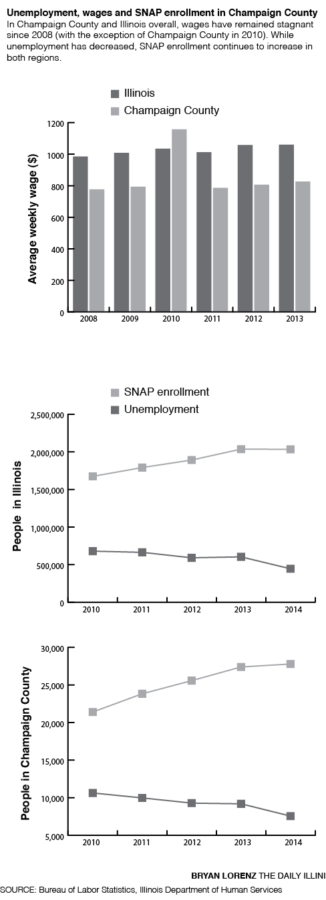SNAP enrollment in Illinois outpaces jobs added, but stagnant wages could be the problem
September 24, 2014
Unemployment in Illinois continues to decrease, whereas the Supplemental Nutrition Assistance Program continues to increase; the largely stagnant wages could explain this trend.
In August, the unemployment rate in Illinois was 6.7 percent, 2.5 percent down from last year, resulting in approximately 169,583 fewer unemployed men and women.
While the total number of SNAP enrollees decreased by 7,850 from August of last year, enrollment is trending upward. In August 2010, nearly 1.7 million Illinois residents were receiving SNAP benefits; today that number is approaching 2.03 million, an increase of almost 20 percent.
State Rep. Naomi Jakobsson, D-103, has taken steps to address the needs of low-income families, including expanding their access to medical care.
“Wages and unemployment are factors that contribute to qualifying for SNAP,” said Jakobsson in an email. “Illinois has expanded Medicaid so that more qualifying children and adults can receive medical care.”
Get The Daily Illini in your inbox!
Champaign County has experienced similar trends in unemployment and SNAP enrollment over the last four years. Since July 2010, Champaign County’s unemployment rate has fallen by 2.3 points, adding just over 3,000 jobs.
Following the statewide pattern, SNAP enrollment in Champaign County has increased over the last four years. In August 2010, almost 22,000 residents were receiving SNAP benefits; today, that number is just over 27,600, demonstrating an increase of roughly 27 percent.
While unemployment has been falling and SNAP enrollment has been rising in both Champaign County and Illinois as a whole, wages have been relatively stagnant. In 2010, the Illinois minimum wage was $8 dollars. Four years later, it has increased by just 25 cents.
According to the Federal Bureau of Labor Statistics, the average weekly wage of an Illinois resident has been hovering near $1,000 since 2008. During the same time period, the average weekly wage for a resident of Champaign County experienced more fluctuation, but remained close to $850.
Brittany Coleman, volunteer coordinator at the Wesley Evening Food Pantry, said that many of the pantry’s customers have jobs, but are still struggling to make ends meet.
“Sometimes they’re just like, ‘you know, I’m working a minimum wage job, it’s full time and it’s still not enough,’ or ‘I’m working part time and I go to school the other part of the time; it’s still not enough,’?” Coleman said.
David Lloyd, director of the Fiscal Policy Center at Voices for Children, said that SNAP is a powerful tool for fighting poverty and making sure that the children of low-income families have access to the resources they need. Without adequate nutrition, Lloyd explained, it is significantly more difficult for these children to grow and develop properly.
“There are a lot of families who are struggling because even though the parents are working, they’re working for very low wages,” said Lloyd. “Children in families who can’t afford basic necessities are much more likely to experience harmful levels of stress, are more likely to struggle in school and are more likely to have health problems than their peers.”
While SNAP can be very helpful for families that are struggling to pay the bills, the average monthly SNAP benefit for a member of an enrolled household is close to $131 a month, which translates to just $1.45 per meal per person. Increasing the minimum wage, Lloyd said, would be a positive first step to help workers support their families and eventually move more people off SNAP programs altogether.
“One of the things that we think needs to be done is to increase the state’s minimum wage; that will help families no longer need food assistance,” Lloyd said.
Josh can be reached at [email protected].







